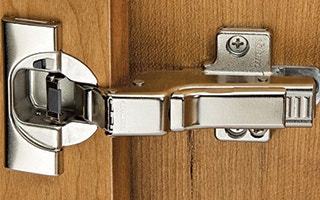Drilling Jigs for European Hinges
When installing a European style hinge, drilling the hinge cup hole in the back of the cabinet door is the first and most crucial task. This sometimes puts people off. They imagine it has to be done with great precision and is therefore painstakingly difficult to achieve. They’re half right. Both the size and the placement of the hinge cup hole are extremely important to the end functioning of the hinge. But once you’re set up with a couple of specialized tools, the process isn’t much of a challenge. Even better, because European hinges are highly standardized, getting set up to do it right is a one shot deal.
Luckily for all concerned, the vast majority of European hinge cups fit perfectly into single, 35mm-in-diameter sized hole. And the placement of the hole, while exacting, falls in one of two places for a great many popular hinges: centered on either 22.5mm or 20.5mm from the edge of the door. So, to install the cups of a huge variety of hinges, all you need to be able to do is consistently drill one size of hole in one of two spots. In the cabinetmaking industry where time is of the essence, sophisticated methods for drilling hinge bores have long been in practice. For small operations and hobbyists, specialized hinge jigs can yield every bit as accurate results in only a slightly longer time. Here are a few of our top choices, beginning with a system that’s been with us for a very long time.
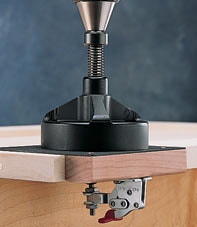
The Concealed Hinge drilling guide is available in its basic form for a total of around $40. This clever set-up consists of a drill guide outfitted with a Long Shank Carbide Forstner Bit and a steel template used to position the bit. Attached to the template are a 3/4” hardwood block, which acts a positioning stop, and a toggle clamp, which holds the template firmly in place.
The Jig-It sets up quickly. The steel template is predrilled on one side with screw holes that automatically center the cup hole at your choice of 20.5mm or 22.5mm from the edge of the door. On the other side of the template, two screw slots allow infinitely variable positioning of the hinge cup hole for anything that doesn't follow either of the two pre-set options. The drill guide comes with a 35mm carbide tipped Forstner bit already installed, a return spring to hold the bit up and out of the way until you’re ready to drill, and an adjustable stop collar, which comes pre-set to drill a hole at the very common depth of 13mm.
To use the jig, you position it in the desired spot along the edge of the door, clamp it in place – making certain that the wood stop block is up tight against the door’s back edge – fit the drill guide over the template and drill until the stop collar has fully compressed the return spring and you're prevented from going any farther. It’s that simple.

The vertical placement of the hinge cup holes – how far they are from the top and bottom of the door – is less crucial. For an average sized cabinet door, 3” from the top and bottom is common. Whatever you choose, it is important keep track of the distance from the top and bottom edge of the door to the center of the cup hole; you’ll need that dimension later on when you position the hinge plates on the cabinet.
When it comes to positioning the cup holes vertically on the edge of the door, it’s best to develop a system and stick with it. The JIG IT Deluxe Concealed Hinge Drilling System can help with that. The concealed hinge drilling systems comes with a 36” aluminum T-track and two drilling templates. The templates attach to the T-track with included T-bolts and knobs, allowing you to position two hinge cup holes at a time. There’s also a handy stop block, which is used to set the distance from the top or bottom of the door to the cup hole. It’s a great system for projects involving multiple doors of the same size. Just set the Multi Tool Rail up once and have at it. When it’s time to install the hinge plates, you’ll know that each and every door is set up with identically spaced hinge cup holes.
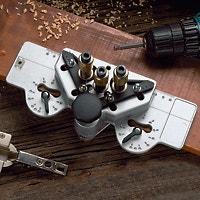
If a little extra speed and convenience are important, and you don’t mind spending a little more, the 35mm Euro Hinge Drilling Jig from Hettich offers a very slick system. The jig drills the standard 35mm cup hole and hinge screw pattern using three integrated, permanently mounted drill bits. All of the bits are powered by the same hex drive, so you can quickly drill all three holes without having to change tooling. The jig has indexed settings for a number of hinge cup tabs (“tab” is the term commonly used for the distance from the edge of the cup hole to the edge of the door). And it can be set up to drill either small pilot holes for hinges held in place with screws or the 8mm holes used with expansion dowel hinge installation. If you own a drill press, you may prefer to use it to drill your hinge cup holes. The drill press method is quick and easy, and will insure that the cup holes are perpendicular to the surface of the door. The only thing that could possibly slow you down or pose a problem is the set up. You’ll need to position a fence on the drill press table that positions the door for the correct cup hole location. Rockler offers a number of handy UHMW plastic Hinge Jigs that are designed just for the task.
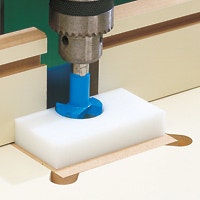
Finally, here’s an option that doesn’t rely on a drill for cutting the hinge cup hole. Rockler’s Concealed Hinge Router Jig-It, you can buzz out 35mm cup holes quickly and efficiently with a plunge router. Like the Jig-It drilling jig, the Router Jig-It comes pre-drilled with screw holes to set up for holes centered on either 22.5mm or 20.5mm from the edge of the door.
Instead of clamping to the door, the Router Jig-It is screwed in place on the door using the hinge screw holes. While the screw-on template method may add a few seconds to the procedure, it does insure that the template will remain absolutely stock-still on the edge of the door, and because there is no clamping mechanism to contend with, you can lay the door completely flat and supported on your workbench during the process. When it’s time to install the hinge, you’ll have two perfectly aligned screw holes all set to go.
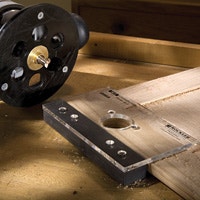
Which one should you get? If you frequently make multiple cabinets, the ability to drill two hinge cup holes with a single set-up afforded by the JIG IT Deluxe Concealed Hinge Drilling System is a great thing to have. The 35mm Euro Hinge Drilling Jig from Hettich, although more expensive and limited to a single cup hole size, is fast, accurate and durable enough for thousands of hinges. For drill press owners, picking up a few Hinge Cup Drilling Set Up Jigs is the most affordable (although certainly not portable) way to go. And if you’re comfortable with a router, you won’t find a faster method for the actual cutting of the hole the Concealed Hinge Router Jig-It. In the end, the choice really boils down to shades of difference in the procedure and the price. Whichever route you choose, you can expect the same results: perfectly sized and positioned cup holes for the most popular cabinet hinge on the planet.
Keep the inspiration coming!
Subscribe to our newsletter for more woodworking tips and tricks
